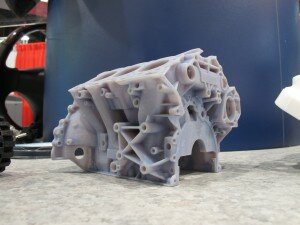 Back in January, innovation leader company Stratasys made our headlines for the first 3D color printer in existence–a massive milestone in the development of this already revolutionary industry.
Back in January, innovation leader company Stratasys made our headlines for the first 3D color printer in existence–a massive milestone in the development of this already revolutionary industry.
Although three-dimensional printing has been around for over twenty years, it seems as if it’s only recently that the potential seems to be truly unleashed. Stratasys CEO Scott Crump compares 3D printers to the evolution of personal computers and laptops. Once a rare and unique luxury, the machines will soon be more reasonably price and readily available.
And as it turns out, isn’t too far away from us in here in Nebraska. The company is headquartered in the Midwest up north in Eden Prairie, Minnesota with about 1,800 employees. This March, profiled Stratasys and reported that 3D printing is not only an exciting development, but is in fact the next stage of the world’s industrial revolution. And to think, it all began with creating toys for Crump’s two-year old daughter.
The CEO of one of the largest 3D manufacturing and printing companies was an engineer who had been working in the semiconductor industry before his life changed during the process of making a little froggy for his daughter to entertain her. “I wanted to make her a froggy, so I used a glue gun loaded with a mixture of polyethylene and candle wax,” Crump told TCB. “The frog was layered. What came out looked more like Lincoln Logs, but in building those up, I could build up a frog.”
That same technology, fused-deposition modeling, is now a $5 billion dollar company and is used for much more than little frogs. From food to canoes, to even houses, it’s apparent to everyone in the manufacturing and engineering industries that we’re on the verge of simply creating things in a different way. Hence, the idea of an industrial revolution. And did we mention that Stratasys has already 3D printed a car?
The dean of the College of Design at the University of Minnesota, Tom Fisher, tells the magazine that “an industrial revolution is marked when people start making things differently. The digital revolution started this and was a nice prelude, but it wasn’t enough, because we were still mass-producing things in the old way, just making it more efficient through digital means,” says Fisher. “With 3D printing we can make new products. It will be a revolution of mass-customization.”
There are absolutely a few barriers to this revolution: For example, experts agree that the design tools need to catch up to the creation technology before it’s easy for anyone to buy a design and print it. The other issue is the question of multi-material printing and how that will evolve in subsequent years.
What do you think–is this the next industrial revolution, and how exactly will this printing impact future systems and manufacturing?
(And, if you’re interested about learning of in this field, visit the career section on the Stratasys website for more information.)
—
Photo credit:
 Official Nebraska Government Website
Official Nebraska Government Website
